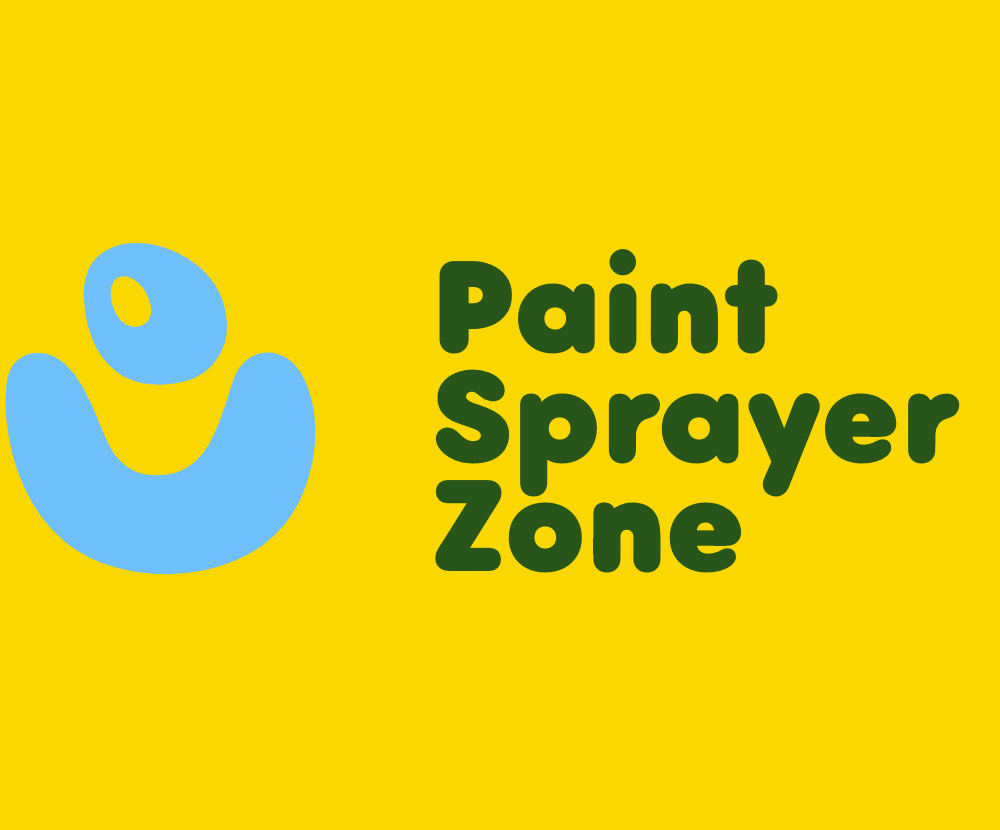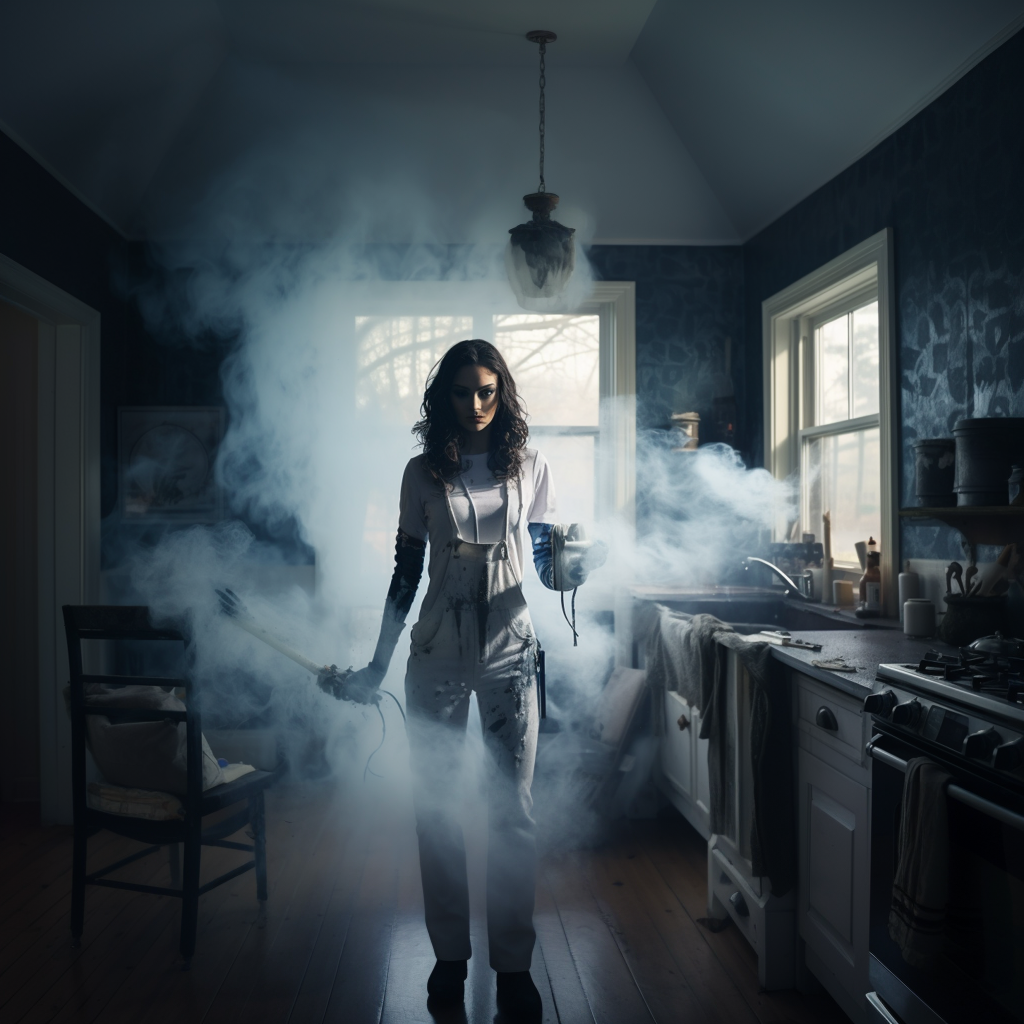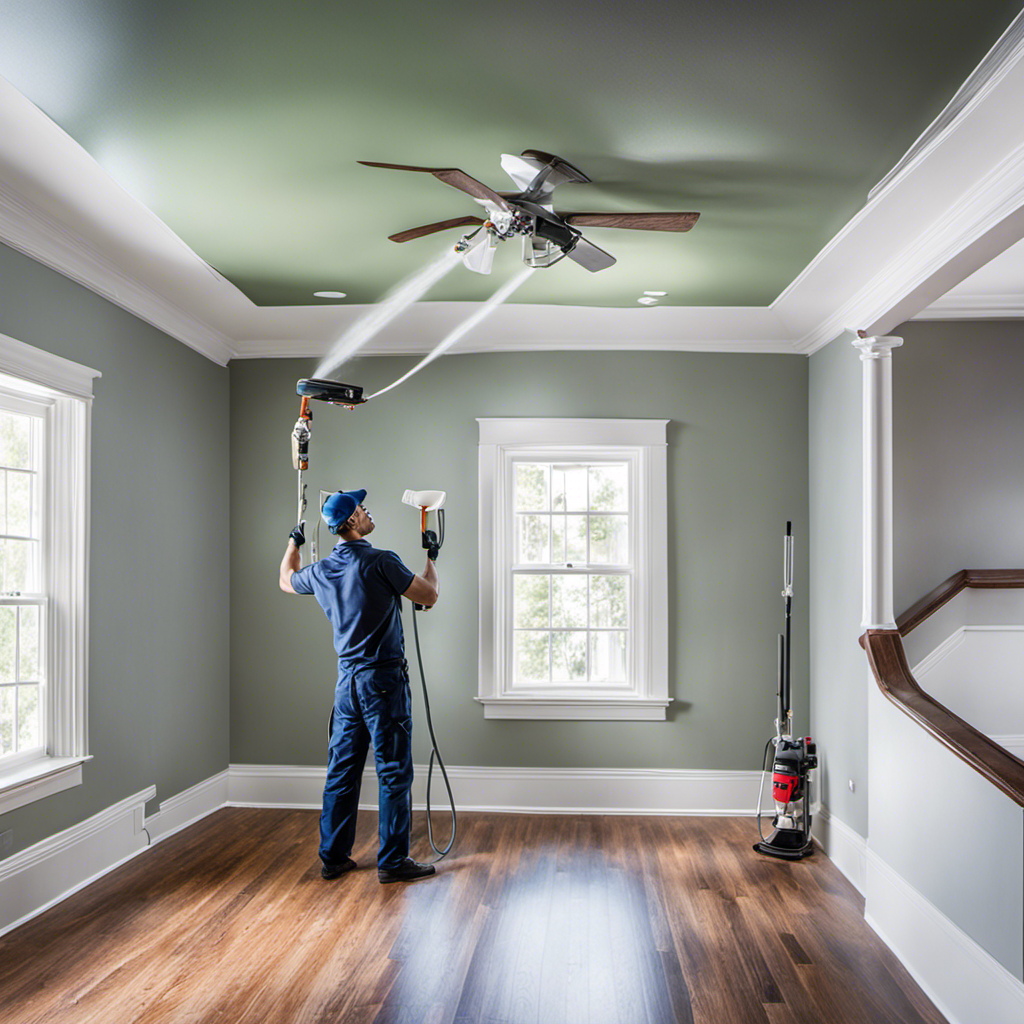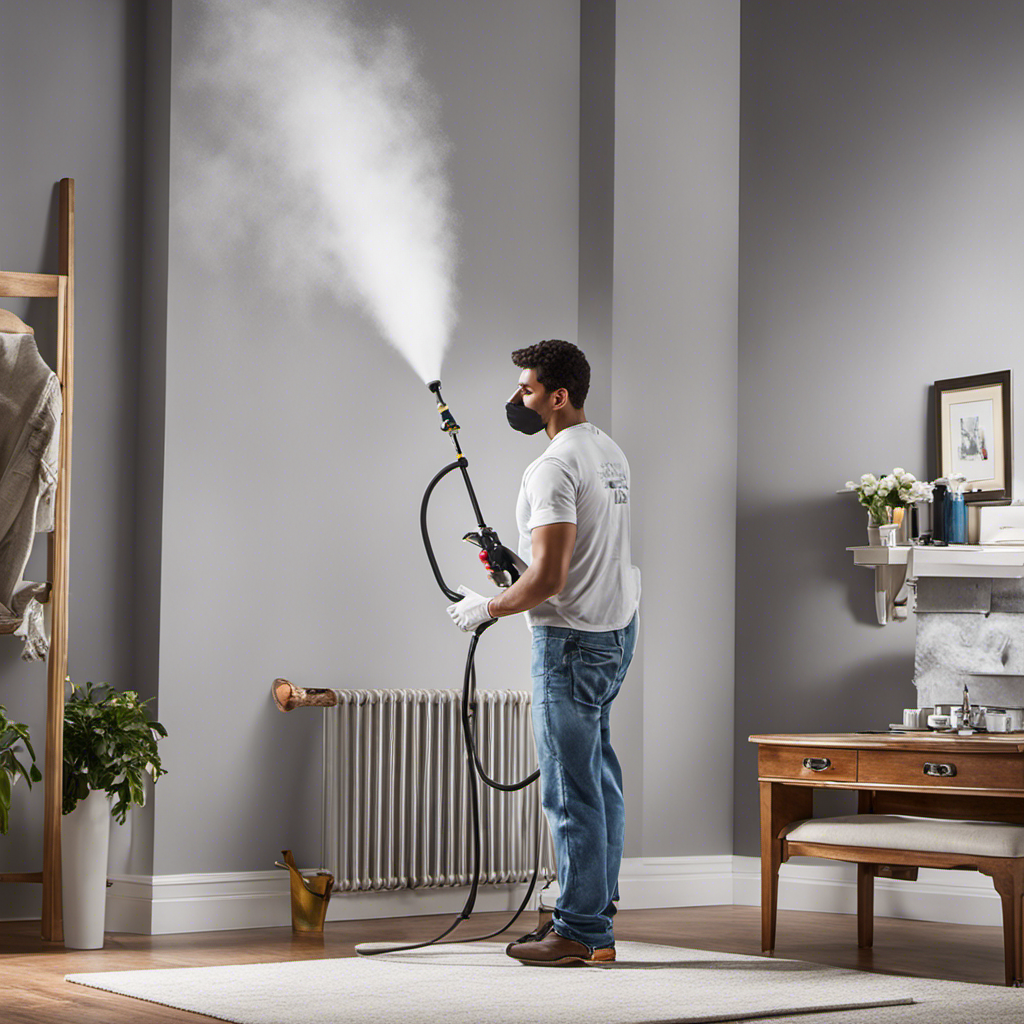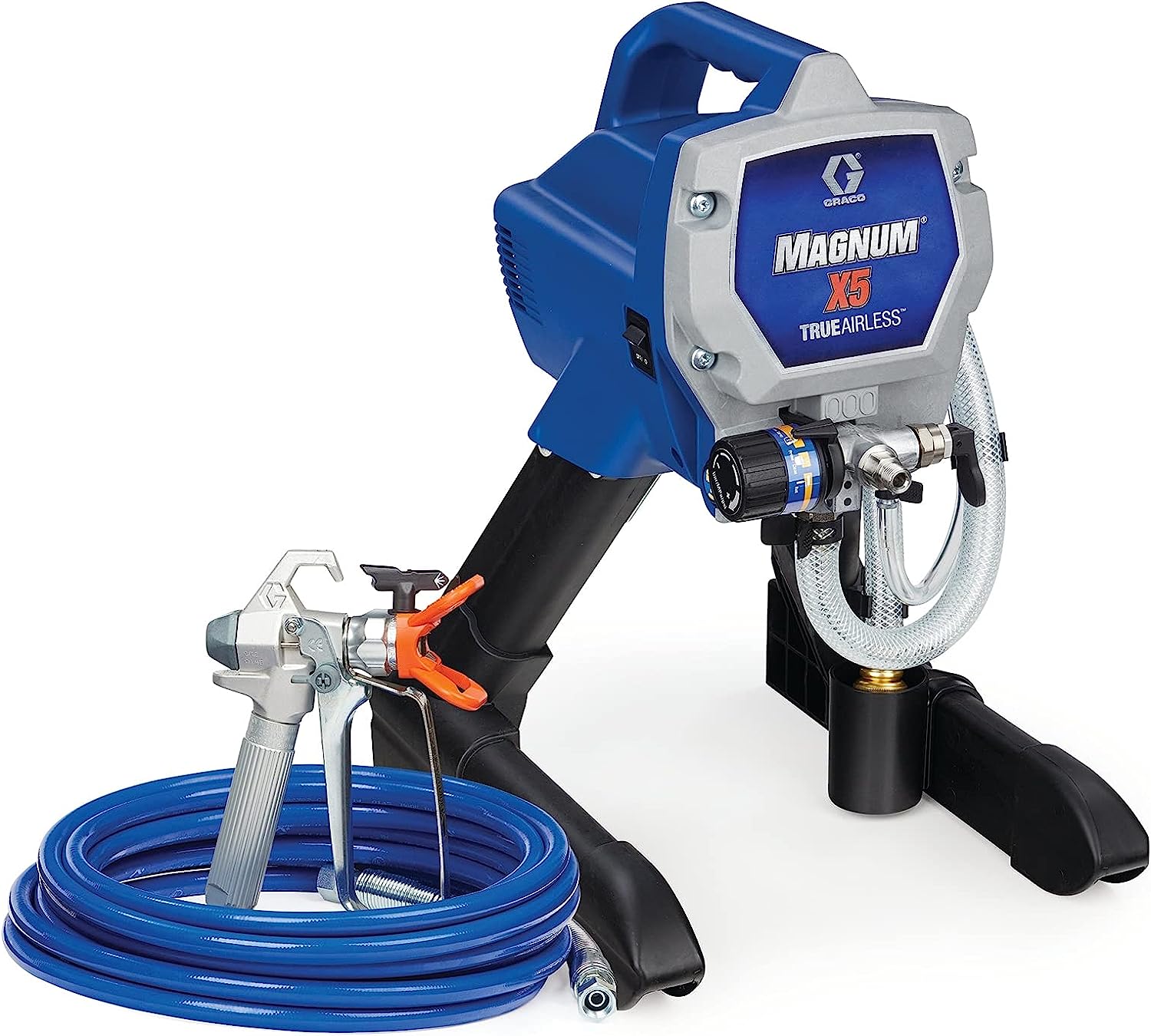Paint Sprayer Maintenance and Troubleshooting
What Happens When You Get Shot by a Airless Paint Sprayer
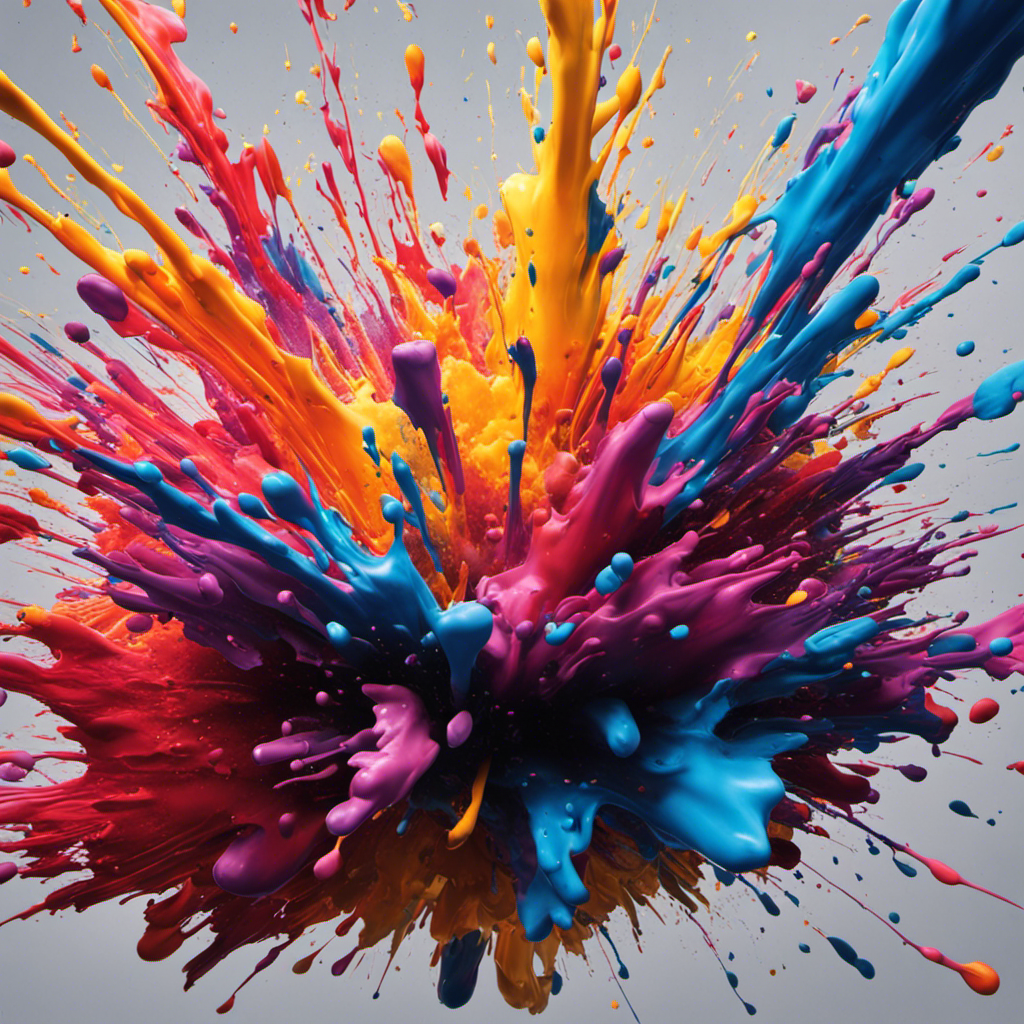
Have you ever thought about what happens if you get hit by a spray from an airless paint sprayer? Let me tell you, it’s anything but a pleasant experience.
In this article, we will delve into the mechanics of an airless paint sprayer, understand the pressure behind the spray, and explore the potential injuries caused by it.
We’ll assess the severity of wounds, discuss long-term effects and complications, and provide steps for proper treatment and recovery.
Plus, we’ll share safety measures to prevent these accidents.
So, let’s dive in and uncover the truth about getting shot by a paint sprayer.
Key Takeaways
- Airless paint sprayers operate without compressed air and use a nozzle to determine the size and shape of the spray pattern.
- Regular cleaning and inspection of the sprayer, especially the nozzle, is important for optimal performance.
- Different nozzles are available for different types of projects.
- Paint from an airless paint sprayer can cause skin irritation, allergic reactions, respiratory issues, and potential damage to the eyes and skin.
The Mechanics of an Airless Paint Sprayer
The mechanics of an airless paint sprayer allow for high-pressure paint spraying without the need for compressed air. Understanding the paint nozzle is key to operating this type of sprayer effectively. The nozzle determines the size and shape of the spray pattern, and different nozzles are available for different types of projects. It is important to choose the right nozzle for the desired outcome.
Additionally, paint sprayer maintenance is crucial for optimal performance. Regular cleaning and inspection of the sprayer, especially the nozzle, will prevent clogs and ensure a consistent spray pattern. Taking the time to understand the mechanics of an airless paint sprayer and properly maintaining it will result in smooth and efficient painting projects.
Now, let’s delve into understanding the pressure behind the spray.
Understanding the Pressure Behind the Spray
Understanding the pressure behind the spray in an airless paint sprayer is crucial. Proper pressure management ensures a high-quality paint application and reduces the risk of accidents. Let’s take a closer look at the pressure levels commonly used in airless paint sprayers:
| Pressure Level | PSI Range | Application |
|---|---|---|
| Low Pressure | 500-1000 PSI | Fine finishing, delicate surfaces |
| Medium Pressure | 1500-2000 PSI | General purpose, walls, ceilings |
| High Pressure | 2500-3500 PSI | Heavy coatings, thick materials |
When working with an airless paint sprayer, it is essential to follow safety precautions to prevent injuries. Wear protective clothing, including goggles, gloves, and a respirator. Keep a safe distance from the sprayer and ensure proper ventilation in the working area. Additionally, always release the pressure before cleaning or performing maintenance on the sprayer.
Understanding the pressure behind the spray helps us comprehend the impact on the skin when the paint hits.
Impact on the Skin: What Happens When the Paint Hits
When paint is sprayed onto the skin, it can cause irritation and potential damage. The force of the paint splatter can lead to several negative effects on the skin, including redness, itching, and inflammation.
Here are three key things to understand about the impact of paint on the skin:
-
Chemical composition: Paint contains various chemicals and pigments that can be harmful when they come into contact with the skin. These substances can penetrate the outer layer of the skin and cause irritation.
-
Allergic reactions: Some individuals may be allergic to certain components in paint, such as solvents or dyes. This can result in more severe skin reactions, such as blistering or hives.
-
Long-term effects: Prolonged or repeated exposure to paint splatter can lead to chronic skin conditions, such as dermatitis or eczema.
Understanding these factors is crucial in order to prevent and address potential injuries caused by the paint sprayer, which will be discussed in the following section.
Potential Injuries Caused by the Paint Sprayer
When it comes to using a paint sprayer, there are several potential dangers to be aware of.
One of the most significant risks is the inhalation of paint fumes, which can lead to respiratory issues and other health problems.
Additionally, the paint can cause damage to the eyes and skin upon contact, making it crucial to take proper safety precautions when using a paint sprayer.
Paint Inhalation Dangers
Paint inhalation dangers can occur when you’re exposed to the fumes from an airless paint sprayer. The toxic chemicals released in the form of paint fumes can have serious consequences on your respiratory system.
Here are three reasons why paint inhalation can lead to respiratory problems:
-
Irritation: Breathing in paint fumes can irritate your nose, throat, and lungs, causing symptoms such as coughing, wheezing, and shortness of breath.
-
Allergic reactions: Some people may be allergic to certain chemicals present in paint, leading to allergic rhinitis, asthma attacks, or even anaphylaxis.
-
Long-term damage: Prolonged exposure to paint fumes can result in chronic respiratory conditions, including bronchitis and lung cancer.
As you can see, inhaling paint fumes can have detrimental effects on your respiratory health. However, it’s important to note that the dangers don’t stop there.
Eye and skin damage can also occur from direct contact with the paint, which I will discuss in the next section.
Eye and Skin Damage
If you’re not careful, direct contact with paint can cause damage to your eyes and skin. That’s why it’s important to always wear proper eye protection when working with paint, such as safety goggles or a face shield.
Paint can irritate the eyes and cause redness, itching, and sometimes even more serious injuries like chemical burns. If you do get paint in your eyes, it’s crucial to seek immediate medical attention.
The treatment options for eye injuries caused by paint will depend on the severity of the damage. In less severe cases, rinsing the eyes with clean water may be sufficient. However, more severe injuries may require specialized treatment, such as eye drops, medications, or even surgery.
Assessing the damage: severity of wounds, will help determine the appropriate course of action.
Assessing the Damage: Severity of Wounds
When it comes to assessing the seriousness of wounds, it is crucial to consider various factors. These factors include the depth, size, and location of the injury. These factors play a significant role in determining the potential complications that may arise. These complications can include infection or damage to underlying structures.
Once the severity and potential complications have been assessed, appropriate treatment options can be explored. These treatment options range from basic wound care techniques to more advanced medical interventions.
Determining Wound Seriousness
Assessing the severity of the wound caused by an airless paint sprayer can be done by considering the depth and size of the injury. When determining wound severity, it is important to take into account the following factors:
- Depth of the wound: A deeper wound may indicate a more serious injury, as it can damage underlying tissues and organs.
- Size of the wound: Larger wounds often require more extensive treatment and may have a longer healing process.
- Location of the wound: Depending on where the wound is located, there may be a higher risk of complications or difficulties in the healing process.
Understanding these aspects is crucial in determining the seriousness of the injury and providing appropriate medical care. By assessing the depth, size, and location of the wound, healthcare professionals can develop an effective treatment plan and monitor the wound healing process.
However, it is also important to assess potential complications that may arise from an airless paint sprayer injury.
Assessing Potential Complications
To determine the severity of any potential complications, it is important to closely monitor the wound caused by the airless paint sprayer. Complication management is crucial in order to minimize the long-term consequences that may arise from such an injury. Here is a table that provides an overview of the potential complications and their respective management strategies:
| Complication | Symptoms | Management |
|---|---|---|
| Infection | Redness, swelling, pus | Clean the wound, apply antibiotic ointment, seek medical attention if symptoms worsen |
| Tissue damage | Bruising, pain, stiffness | Apply ice, elevate the affected area, consult a healthcare professional for further evaluation |
| Scarring | Raised, discolored skin | Apply silicone gel, use sunscreen to protect the area from UV exposure, consider scar revision surgery if necessary |
| Nerve damage | Numbness, tingling | Consult a healthcare professional for evaluation and possible rehabilitation |
| Psychological impact | Anxiety, fear | Seek support from loved ones, consider therapy or counseling if necessary |
Treatment Options for Wounds
There are several treatment options available for wounds caused by an airless paint sprayer. When it comes to wound care, it is important to consider the severity of the injury and the extent of the damage. Here are three treatment options that can be considered for paint sprayer injuries:
-
Cleaning the wound: The first step in treating a paint sprayer wound is to clean it thoroughly. This involves gently washing the area with mild soap and water to remove any paint residue or debris that may be present.
-
Antibiotic ointments: Applying an antibiotic ointment to the wound can help prevent infection and promote healing. This should be done after cleaning the wound and can be followed by covering it with a sterile dressing.
-
Seeking medical attention: In some cases, paint sprayer wounds may be deep or severe and require medical intervention. It is important to seek professional medical help if the wound is large, bleeding heavily, or if there are signs of infection such as redness, swelling, or pus.
Transitioning into the subsequent section about immediate first aid for paint sprayer injuries, it is crucial to act quickly in order to minimize the potential risks and complications associated with such injuries.
Immediate First Aid for Paint Sprayer Injuries
If you get shot by an airless paint sprayer, the first thing you should do is clean the wound and apply pressure to stop the bleeding. Immediate first aid is crucial to prevent potential complications and minimize the risk of infection. After cleaning the wound, it is important to cover it with a sterile dressing to protect it from further contamination. Here is a table that highlights the potential complications of paint sprayer injuries and some tips for preventing accidents:
| Complications | Prevention Tips |
|---|---|
| Infection | Use personal protective equipment such as gloves and goggles. Clean the equipment regularly. |
| Tissue damage | Follow the manufacturer’s instructions for proper use of the paint sprayer. Maintain a safe distance from the spraying area. |
| Allergic reactions | Avoid using paint sprayers if you have a known allergy to the chemicals used. Perform a patch test before using new products. |
| Eye injuries | Wear protective eyewear to shield your eyes from accidental splashes or sprays. |
Long-Term Effects and Complications
Remember, regular check-ups with a healthcare professional are essential to monitor any potential long-term effects and complications from your injury. It’s important to understand the possible consequences of being shot by an airless paint sprayer.
Here are three key points to consider:
-
Long-term effects: Depending on the severity of the wound, you may experience long-term effects such as chronic pain, limited mobility, or even nerve damage. These effects can significantly impact your daily life and require ongoing medical attention.
-
Complications: Paint sprayer injuries can lead to complications such as infections, scarring, or tissue damage. These complications may require additional treatment options, such as antibiotics or surgeries, to ensure proper healing and prevent further issues.
-
Treatment options: The treatment for long-term effects and complications will vary based on the specific injury. It may involve physical therapy, medication, wound care, or even rehabilitation programs. Consulting with a healthcare professional will help determine the most suitable treatment plan for your situation.
Understanding the potential long-term effects and complications of a paint sprayer injury highlights the importance of seeking prompt medical attention.
Seeking Medical Attention: When and Why
After discussing the long-term effects and complications of getting shot by an airless paint sprayer, it is important to understand when and why seeking immediate medical attention is crucial.
When it comes to injuries caused by paint sprayers, it is always better to err on the side of caution and seek medical help as soon as possible. The force and pressure of the paint can cause internal damage that may not be immediately apparent. Furthermore, there is a risk of infection from the paint entering the body. Seeking medical attention promptly can help prevent further complications and ensure proper treatment is administered. With the potential seriousness of this type of injury, it is essential not to delay in seeking medical care.
Transitioning to the subsequent section on steps to take for proper treatment and recovery, it is important to know what actions to take after seeking medical attention.
Steps to Take for Proper Treatment and Recovery
When it comes to dealing with injuries caused by an airless paint sprayer, there are three key points to consider:
-
Immediate first aid is crucial in order to minimize further damage and prevent infection.
-
Seeking medical attention is essential to properly assess and treat the injury, as well as to ensure any underlying complications are addressed.
-
The long-term recovery process may involve physical therapy, wound care, and ongoing medical treatment to achieve optimal healing and function.
Immediate First Aid
If you get shot by an airless paint sprayer, you should immediately rinse the affected area with clean, cool water. This is crucial for paint sprayer safety and proper wound care.
Here are three important things to keep in mind when dealing with this type of injury:
-
Remove any clothing or jewelry near the wound to prevent further irritation or contamination.
-
Gently pat the area dry with a clean towel or cloth after rinsing to avoid causing additional damage to the skin.
-
Apply a sterile, non-stick bandage or gauze pad to protect the wound from dirt and bacteria.
Medical Attention Required
Remember, it’s crucial to seek immediate medical attention for a gunshot wound caused by an airless paint sprayer.
The severity of the injury may not be immediately apparent, so it is important to be aware of the warning signs and symptoms that may indicate the need for medical attention. These can include severe pain, excessive bleeding, difficulty breathing, or signs of infection such as redness, swelling, or pus.
To assess the severity of the injury, you can perform a self-assessment by checking for any obvious entry and exit wounds, evaluating the amount of bleeding, and assessing your overall physical condition. However, it is important to note that even if the injury appears minor, it is still recommended to seek medical attention as there may be internal damage that needs to be addressed.
Moving forward into the long-term recovery process, it is crucial to follow the guidance and treatment plan provided by medical professionals to ensure proper healing and minimize the risk of complications.
Long-Term Recovery Process
To ensure proper healing and minimize the risk of complications, it’s crucial that you follow the guidance and treatment plan provided by medical professionals during your long-term recovery process.
The rehabilitation process after being shot by an airless paint sprayer can be challenging, both physically and mentally. Here are three important aspects to consider:
-
Physical therapy: Engaging in exercises and stretches recommended by your healthcare provider can help restore strength and mobility to the affected area. This may involve using specialized equipment or undergoing manual therapy techniques.
-
Psychological support: Dealing with the aftermath of such an incident can have a significant psychological impact. Seeking therapy or counseling can provide a safe space to process emotions, manage anxiety, and build resilience during the recovery journey.
-
Follow-up appointments: Regular check-ups with your healthcare team are essential for monitoring progress, addressing any concerns, and adjusting the treatment plan accordingly.
Transitioning into the subsequent section about preventing paint sprayer accidents: safety measures to follow, it’s important to take proactive steps to avoid such incidents in the first place.
Preventing Paint Sprayer Accidents: Safety Measures to Follow
Following safety measures is crucial when using a paint sprayer to prevent accidents. As someone who has experienced the dangers of paint sprayer accidents firsthand, I cannot stress enough the importance of taking precautions.
First and foremost, always wear protective gear, including goggles, gloves, and a respirator mask, to shield yourself from harmful fumes and overspray.
Additionally, ensure that the work area is well-ventilated to minimize the risk of inhaling toxic chemicals. It is also essential to read and understand the manufacturer’s instructions before operating the paint sprayer, as each model may have specific safety guidelines.
Frequently Asked Questions
Can an Airless Paint Sprayer Cause Permanent Damage to the Skin?
An airless paint sprayer can cause permanent damage to the skin, including permanent scarring. This can have legal implications if someone is injured by the sprayer. It is important to take proper precautions when using such equipment.
Are There Any Long-Term Health Complications That Can Occur From Being Shot by an Airless Paint Sprayer?
Long-term health complications can arise from being shot by an airless paint sprayer. Treatment options vary depending on the severity of the injury. It’s crucial to seek medical attention immediately to minimize potential damage.
What Steps Should Be Taken Immediately After Being Shot by an Airless Paint Sprayer to Minimize Injury?
After getting shot by an airless paint sprayer, the immediate steps to minimize injury include seeking medical attention, cleaning the wound with antiseptic techniques, and starting the rehabilitation process for a successful recovery.
How Long Does It Typically Take to Recover From Injuries Sustained From an Airless Paint Sprayer?
Recovery timeline and the rehabilitation process can vary depending on the severity of the injuries sustained from an airless paint sprayer. It’s important to consult with medical professionals for an accurate assessment and personalized treatment plan.
What Safety Measures Should Be Followed to Prevent Accidents With Airless Paint Sprayers?
To prevent accidents with airless paint sprayers, it is crucial to prioritize proper training and avoid common mistakes. This ensures safety for all involved and minimizes the risk of harm.
Conclusion
In conclusion, experiencing the impact of an airless paint sprayer is a chilling and terrifying ordeal. The force behind the spray can cause severe damage to the skin, leaving behind painful wounds that may have long-term effects.
The image of paint forcefully penetrating the skin is enough to send shivers down one’s spine. It is crucial to seek immediate medical attention and follow proper treatment protocols to ensure a successful recovery.
Remember, taking necessary safety measures is the key to preventing such accidents and protecting oneself from this haunting experience.
Drenched in creativity and armed with a fountain pen, Isolde weaves words as gracefully as a painter strokes their canvas. A writer for Paint Sprayer Zone, her passion for colors, textures, and spaces finds a harmonious blend with her profound knowledge of painting tools and techniques.
Having grown up in a family of artists, Isolde’s tryst with paints began early. While her relatives expressed themselves on canvas, Isolde found her medium in words. She dedicated herself to chronicling the world of painting, understanding the nuances of each tool, and the artistry behind every spritz of a paint sprayer.
Paint Sprayer Maintenance and Troubleshooting
Maximize Your Airless Paint Sprayer’s Lifespan With These Essential Tips
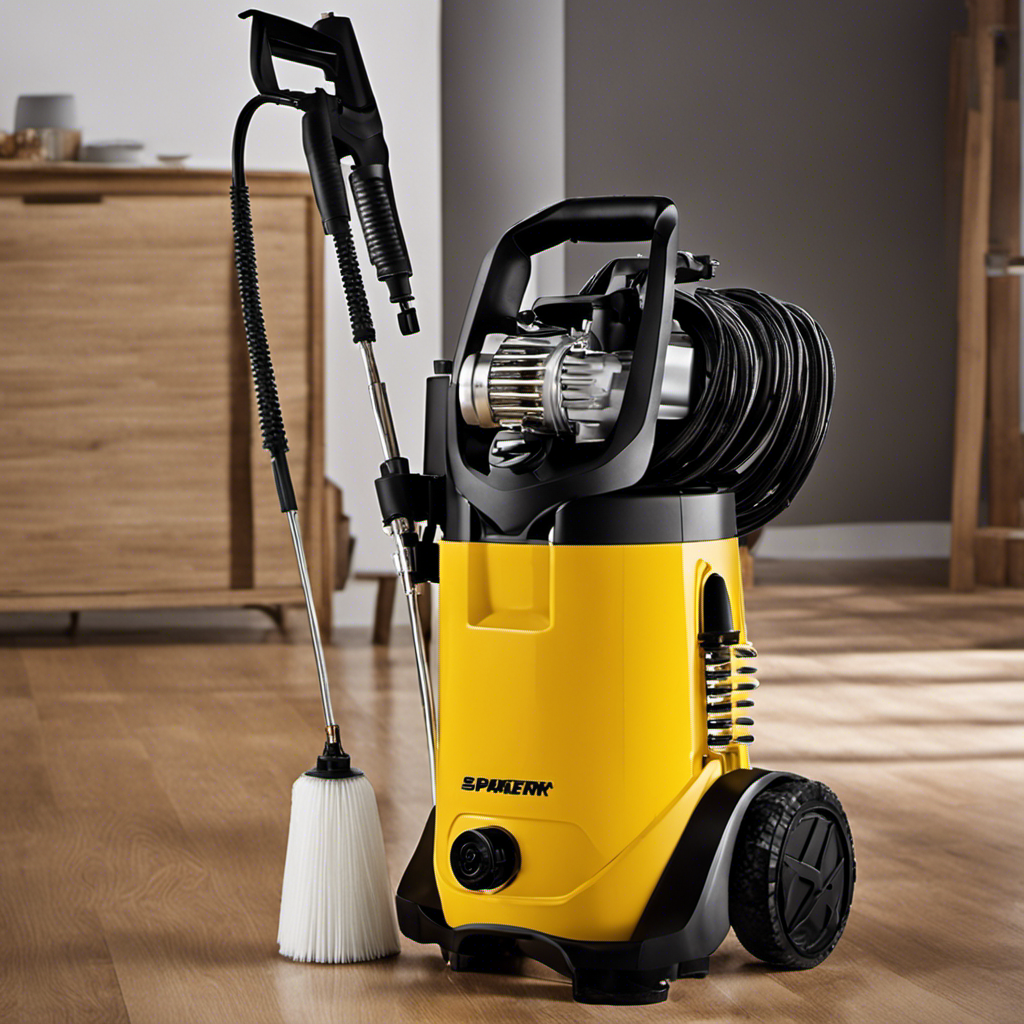
Are you fed up with your paint sprayer malfunctioning when you need it the most? No need to fret, we’ve got your back!
In this article, we’ll provide you with essential tips to maximize the lifespan of your airless paint sprayer. Imagine a paint sprayer that lasts longer, performs reliably, and saves you time and money.
By following these simple yet effective techniques, you’ll ensure proper storage, regular cleaning, and maintenance, and the use of high-quality replacement parts.
So, let’s dive in and make your airless paint sprayer last for years to come!
Key Takeaways
- Proper storage and protection: Clean and dry the sprayer before storage, find a cool and dry place, invest in a protective case, and keep it away from extreme temperatures and moisture.
- Regular cleaning: Clean the spray gun after each use, check and clean the filters regularly, flush out the system, and keep the storage area clean to prevent clogs and blockages.
- Lubrication: Follow manufacturer’s recommendations for oil type and usage, regularly check oil levels, and apply oil to moving parts for smooth operation.
- High-quality replacement parts: Invest in durable and reputable replacement parts, replace worn-out or damaged parts promptly, and use genuine parts to maintain performance and reliability.
Proper Storage and Protection
To maximize your airless paint sprayer’s lifespan, follow these steps:
- Clean the sprayer thoroughly before storage. Ensure all components are dry.
- Find a cool and dry place to store the sprayer.
- Proper sprayer maintenance and effective storage techniques are crucial for keeping your equipment in optimal condition.
After each use:
- Clean the spray gun and check and clean the filters regularly.
- Flush out the entire system with water or a cleaning solution to prevent clogs and blockages.
- Lubricate the sprayer with the manufacturer-recommended oil to reduce friction, wear, and corrosion.
Remember to:
- Invest in high-quality replacement parts to ensure durability and functionality.
- Cheap parts wear out quickly and require frequent replacements.
Thorough Cleaning
Regularly clean the spray gun after each use to prevent clogs and maintain optimal performance. Thorough cleaning techniques are essential to ensure the longevity of your airless paint sprayer.
Start by disassembling the spray gun and removing any paint residue or debris. Use a cleaning solution recommended by the manufacturer and thoroughly clean all the components, including the nozzle and filter.
Pay close attention to the hoses, as they can also become clogged with dried paint. Flush out the entire system with water or the appropriate cleaning solution to ensure all paint particles are removed.
After cleaning, dry all the components thoroughly before reassembling the spray gun. By following these thorough cleaning techniques and using the best cleaning solutions, you can keep your airless paint sprayer in optimal condition and avoid any performance issues.
Regular Filter Maintenance
Ensure you clean and inspect the filters of your airless paint sprayer on a consistent basis to maintain optimal performance. Cleaning the filters regularly is essential to prevent clogs and ensure smooth operation.
The frequency of cleaning will depend on the type and amount of paint being sprayed. As a general rule, it’s recommended to clean the filters after every use or at least once a week for heavy use.
Start by removing the filters from the sprayer and rinse them thoroughly with water or a cleaning solution. Use a soft brush or toothbrush to remove any stubborn debris. Allow the filters to dry completely before reinserting them into the sprayer.
Regularly checking and cleaning the filters will prolong the lifespan of your airless paint sprayer and ensure consistent, high-quality results.
Flushing the System
Flushing the system is an important step in maintaining the performance of your airless paint sprayer. Regular system maintenance ensures optimal performance and prevents clogs or blockages.
To flush the system, start by removing any remaining paint from the sprayer. Then, fill the paint container with a cleaning solution recommended by the manufacturer.
Attach the sprayer to a water source and turn it on. Allow the cleaning solution to flow through the system, flushing out any paint residue or debris. Run the cleaning solution through all components, including the hoses, filters, and nozzle.
Once the cleaning solution runs clear, disconnect the sprayer from the water source and thoroughly rinse the system with clean water.
This flushing technique will help maintain the efficiency and longevity of your airless paint sprayer.
Clean Storage Area
To maintain the cleanliness of your storage area, keep it free from dust or dirt that could potentially enter critical components. Here are some cleaning techniques and tips to prevent dust accumulation:
- Regularly dust and sweep the storage area to remove any loose dirt or debris.
- Use a vacuum cleaner with a brush attachment to clean hard-to-reach areas.
- Wipe down surfaces with a damp cloth to remove any stubborn dust or grime.
- Consider using air purifiers or dehumidifiers to maintain a clean and dry environment.
Store your airless paint sprayer in a protective case or bag to prevent dust from settling on it. Avoid storing the sprayer in areas prone to moisture or dust, such as basements or garages. Cover the sprayer with a cloth or plastic sheet when not in use to further protect it from dust.
Nozzle and Filter Cleaning
Now that you understand the importance of keeping your storage area clean, let’s move on to the next crucial aspect of maintaining your airless paint sprayer: nozzle and filter cleaning.
Regularly cleaning the nozzle and filters is essential for optimal performance and preventing common nozzle issues.
To start, always follow the manufacturer’s instructions for cleaning the nozzle. Typically, this involves removing the nozzle from the spray gun and soaking it in a cleaning solution or using a specialized cleaning brush to remove any paint residue or debris. Be sure to clean the nozzle thoroughly, as any build-up can lead to clogs or uneven spray patterns.
Additionally, it’s crucial to regularly check and clean the filters. These filters help prevent debris from entering the sprayer and can become clogged over time. Simply remove the filters and rinse them with water or a cleaning solution, ensuring all dirt and debris are removed.
Hose Inspection and Cleaning
Make sure you regularly inspect and clean the hoses of your airless paint sprayer to ensure optimal performance. Here are some troubleshooting tips for hose maintenance:
- Check for any cracks or leaks in the hoses
- Inspect the hose fittings for any signs of wear or damage
- Clean the hoses thoroughly after each use to remove any paint residue or debris
- Use a soft brush or cloth to clean the exterior of the hoses
- Flush out the hoses with water or a cleaning solution to remove any clogs or blockages
- Pay attention to any kinks or twists in the hoses and straighten them out if necessary
- Replace any damaged or worn-out hoses promptly to prevent further issues
- Store the hoses in a clean and dry area to prevent them from being exposed to moisture or dust
Lubrication Guidelines
Ensure you consult the manufacturer’s recommendations for the correct oil type to use in your airless paint sprayer. Using the right oil is crucial for optimal performance and longevity. Lightweight mineral-based oil designed for high-pressure applications is typically recommended.
Regularly check the oil level in your sprayer and top up or change the oil as recommended by the manufacturer. Following the proper oiling frequency is important to reduce friction, wear, and corrosion. Apply oil to moving parts to ensure smooth operation, but be cautious not to over-lubricate as it can attract dust and debris.
Regularly check oil levels and refill as needed to maintain the sprayer’s efficiency. By using the appropriate oil and following the recommended lubrication frequency, you can maximize the lifespan of your airless paint sprayer.
Correct Oil Type
Using the recommended lightweight mineral-based oil for high-pressure applications is crucial to ensure optimal performance and longevity of your airless paint sprayer. Choosing the right oil and proper lubrication techniques are essential for maintaining your sprayer.
Here are some key points to consider:
- Use a lightweight mineral-based oil designed for high-pressure applications.
- Regularly check the oil level in the sprayer and top up or change it as recommended.
- Proper oil usage reduces friction, wear, and corrosion in the internal components.
- Apply oil to the moving parts to ensure smooth operation.
- Avoid over-lubricating, as it can attract dust and debris.
- Follow the manufacturer’s guidelines for oiling frequency.
- Regularly check oil levels and refill as needed.
Regular Oil Level Check
Check the oil level in your sprayer regularly to ensure optimal performance and prevent unnecessary wear and tear.
Regular oil level monitoring is crucial for maintaining the efficiency of your airless paint sprayer. Oil acts as a lubricant, reducing friction and preventing corrosion within the internal components.
By regularly checking the oil level and topping up or changing it as recommended by the manufacturer, you can ensure smooth operation and extend the lifespan of your sprayer.
Regular oil changes are important because over time, the oil can become contaminated with debris and lose its lubricating properties. By staying on top of oil changes, you can prevent damage to the sprayer and avoid costly repairs.
Make it a habit to monitor the oil level in your sprayer and perform regular oil changes to keep it running smoothly.
High-Quality Replacement Parts
When it comes to maintaining your airless paint sprayer, using high-quality replacement parts is essential. Genuine parts offer several benefits that can significantly impact the lifespan and performance of your sprayer.
Here are some reasons why using genuine parts is important:
-
Superior Durability and Functionality:
- Genuine parts are designed specifically for your sprayer model, ensuring a perfect fit and optimal performance.
- They are made from high-quality materials, making them more durable and resistant to wear and tear.
- Using genuine parts eliminates the risk of leaks or malfunctions, providing a reliable and efficient spraying experience.
-
Reduced Repairs and Downtime:
- High-quality replacement parts minimize the need for frequent repairs, saving you time and money.
- Genuine parts are less likely to fail or break, preventing unexpected project delays.
- By investing in genuine parts, you can avoid costly downtime and keep your sprayer working at its best.
-
Maintenance and Reliability:
- Genuine parts are manufactured to meet the highest standards, ensuring consistent performance and reliability.
- Regular maintenance, including the use of genuine replacement parts, is crucial for maximizing the lifespan of your sprayer.
- By following recommended maintenance practices and using genuine parts, you can enjoy a reliable and long-lasting airless paint sprayer.
Importance of Premium Parts
Investing in high-quality replacement parts for your airless paint sprayer is essential for durability and optimal performance. Premium parts offer several benefits. Firstly, they are designed to fit and function perfectly, eliminating leaks or malfunctions that can occur with cheaper alternatives. Additionally, premium parts have a longer lifespan, reducing the need for frequent replacements. When choosing replacement parts, consider reputable manufacturers who offer warranties for their products. Ensure that the replacement parts are compatible with your specific sprayer model. Using genuine parts is crucial to maintain performance and reliability. By investing in high-quality replacement parts, you can minimize repairs, extend the lifespan of your sprayer, and ultimately save time and money in the long run.
Reputable Manufacturers for Replacement Parts
Look for warranties provided by reputable manufacturers to ensure the quality and reliability of replacement parts for your airless paint sprayer.
When it comes to finding reliable suppliers for replacement parts, here are a few things to consider:
-
Warranty coverage: Reputable manufacturers often offer warranties on their replacement parts, giving you peace of mind and assurance that the parts are of high quality and built to last.
-
Reputation: Look for manufacturers with a strong reputation in the industry. Reliable suppliers are known for producing top-notch replacement parts that meet or exceed industry standards.
-
Compatibility: Ensure that the replacement parts you choose are compatible with your specific airless paint sprayer model. Reputable manufacturers provide detailed information about compatibility to help you make the right choice.
Timely Replacement of Worn-Out Parts
To ensure optimal performance, regularly replacing worn-out parts is crucial for keeping your airless paint sprayer running smoothly. Timely replacement of worn-out parts is essential for the proper functioning of your sprayer and to avoid any potential breakdowns during your painting projects.
By replacing worn-out parts in a timely manner, you can prevent further damage to your sprayer and ensure its longevity. Not only does timely replacement of parts help maintain the performance of your sprayer, but it also has numerous maintenance benefits. It reduces the risk of malfunctions, leaks, and inefficient paint application. Additionally, it minimizes the need for costly repairs and downtime, saving you both time and money.
Cost and Time Savings With Proper Maintenance
To ensure maximum longevity and performance from your airless paint sprayer, regular maintenance is crucial. By investing a little time and effort into proper care, you can save yourself both money and time in the long run.
Here are the key reasons why regular maintenance is important and the benefits of investing in a protective case:
-
Importance of Regular Maintenance:
- Prevents clogs and blockages, ensuring smooth operation and consistent spray patterns.
- Reduces friction, wear, and corrosion, extending the lifespan of your sprayer.
- Protects the sprayer from cold-related issues, such as freezing or damage to seals and valves.
-
Benefits of Investing in a Protective Case:
- Shields the sprayer from accidental drops, bumps, and impacts.
- Guards against dust, moisture, and other environmental factors that can damage critical components.
- Provides convenient storage and organization for accessories and spare parts.
Frequently Asked Questions
How Often Should I Clean the Spray Gun After Each Use?
To ensure optimal performance, clean the spray gun after each use. This is a crucial step in airless paint sprayer maintenance. Use a cleaning solution recommended by the manufacturer and thoroughly clean all components, including the nozzle and filter.
Regular cleaning prevents clogs and blockages, ensuring smooth operation. By following best practices for cleaning your airless paint sprayer, you can maximize its lifespan and avoid costly repairs.
Can I Use Any Type of Oil for Lubricating the Airless Paint Sprayer?
Yes, you can use any type of oil for lubricating your airless paint sprayer. However, it is important to use the correct oil recommended by the manufacturer for optimal performance and lifespan.
Using the wrong type of oil can lead to friction, wear, and corrosion, causing damage to the internal components. Avoid common mistakes in lubricating airless paint sprayers by consulting the manufacturer’s guidelines and using lightweight mineral-based oil designed for high-pressure applications.
Regularly check the oil level and refill as needed to ensure smooth operation.
How Frequently Should I Check and Clean the Filters?
To extend the lifespan of your airless paint sprayer, it’s important to regularly check and clean the filters. This ensures optimal performance and prevents clogs and blockages. The frequency of checking and cleaning the filters depends on the usage and the type of paint being sprayed.
However, as a general guideline, it is recommended to check and clean the filters after every use or at least once a week for heavy usage. Proper maintenance of the filters will help maximize the lifespan of your airless paint sprayer.
What Are the Benefits of Using High-Quality Replacement Parts?
Using high-quality replacement parts for your airless paint sprayer offers a multitude of benefits. These durable parts ensure proper functionality, eliminating leaks and malfunctions. By investing in premium parts, you can reduce the need for frequent repairs and project downtime.
This not only saves you time but also money in the long run. High-quality replacement parts extend the lifespan of your sprayer, providing reliable performance and enhancing efficiency. So, opt for reputable manufacturers and genuine parts to maximize the durability and longevity of your airless paint sprayer.
How Can Proper Maintenance of the Airless Paint Sprayer Save Me Money and Time in the Long Run?
Proper maintenance of your airless paint sprayer can save you both time and money in the long run. By ensuring proper storage, you protect the sprayer from damage caused by extreme temperatures, moisture, and dust.
Regular maintenance, such as cleaning the spray gun and filters, prevents clogs and blockages that can lead to costly repairs. Using high-quality replacement parts enhances efficiency and reduces project downtime.
Taking these steps will maximize the lifespan of your airless paint sprayer and provide reliable performance.
Conclusion
So there you have it, with these essential tips, you can maximize the lifespan of your airless paint sprayer and enjoy its reliable performance for years to come.
By properly storing and protecting your sprayer, cleaning it thoroughly after each use, and regularly maintaining the filters and system, you can ensure its longevity.
Investing in high-quality replacement parts from reputable manufacturers and timely replacements of worn-out parts will also contribute to cost and time savings.
So take care of your airless paint sprayer and witness the benefits of proper maintenance firsthand.
Franz came aboard the Paint Sprayer Zone team with a background in both journalism and home renovation. His articulate writing style, combined with a passion for DIY projects, makes him an invaluable asset. Franz has a knack for breaking down technical jargon into easy-to-understand content, ensuring that even the most novice of readers can grasp the complexities of paint sprayers.
Paint Sprayer Maintenance and Troubleshooting
Painting Brick Walls With an Airless Sprayer: a Complete Guide
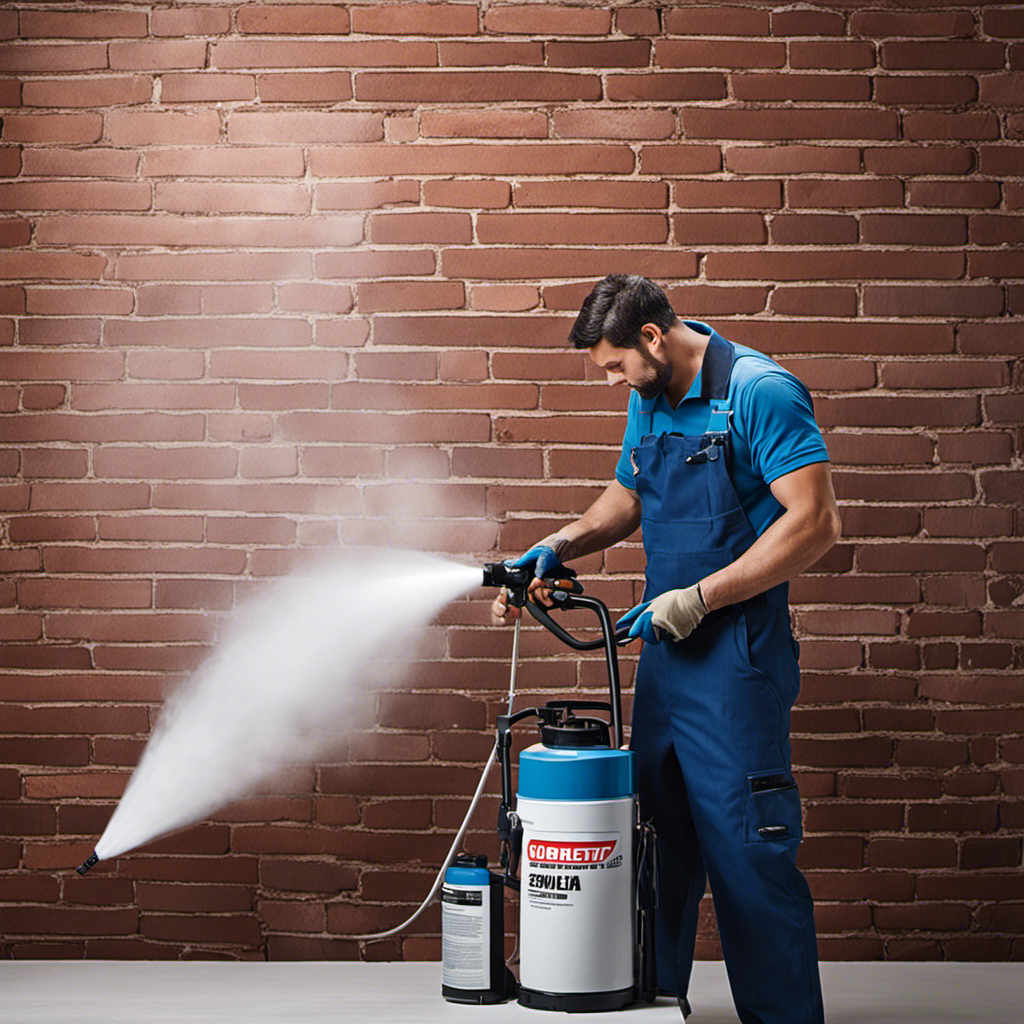
Painting brick walls with an airless sprayer can bring them back to life. This comprehensive guide walks you through every step of the process, from preparing the surface to ensuring an even coat.
With the right tools and materials, including a high-quality primer, you can enhance the durability and resistance of your brick walls. Expert tips and safety precautions ensure a smooth finish and a transformation that will leave your walls looking brand-new.
Get ready to bring new vibrancy and timeless beauty to your space.
Key Takeaways
- Preparation and surface cleaning is essential before painting brick walls with an airless sprayer.
- Selecting the right paint color and gathering the necessary materials and equipment are crucial for a successful painting project.
- Cleaning and maintaining the painted brick walls regularly will help them stay in good condition.
- Priming the walls with a high-quality primer designed for masonry surfaces enhances adhesion, durability, and resistance to moisture and alkali.
Surface Preparation: Tools and Cleaning
The homeowner gathers the necessary tools, including a wire brush, scraper, and power washer, to remove loose paint and dirt from the brick walls. Acquiring these tools is essential for proper cleaning techniques.
Using the wire brush and scraper, the homeowner meticulously removes any loose paint and dirt from the surface of the brick walls. After that, a power washer is used to thoroughly clean the walls, ensuring a clean and smooth surface for painting.
It is important to allow the walls to dry completely before proceeding to the next step. By acquiring the necessary tools and following proper cleaning techniques, the homeowner ensures a clean and well-prepared surface for painting the brick walls.
Selecting the Right Paint Colors and Materials
When selecting paint colors and materials, it is important to consider the desired aesthetic and gather the necessary tools. Choosing paint colors that complement the overall look and feel of the space is crucial for achieving the desired result.
Additionally, having the right materials is essential for a successful painting project. Following a step-by-step guide for surface preparation is also crucial. This includes gathering tools such as a wire brush, scraper, and power washer. It is important to remove loose paint and dirt from the surface using the wire brush and scraper, and then thoroughly clean the area with a power washer.
Once the surface is clean and dry, you can proceed with choosing the appropriate paint color and gathering the necessary materials and equipment like paint, primer, drop cloth, painters tape, and sandpaper.
Essential Equipment for Painting Brick Walls
To achieve a flawless result, one must ensure they have the essential equipment necessary for painting brick walls. This includes proper airless sprayer maintenance and choosing the right paintbrush.
Here are three key items to consider:
-
Well-maintained airless sprayer: Regularly clean and inspect the sprayer to ensure it functions properly. This will ensure consistent paint application and prevent clogging or uneven spraying.
-
High-quality paintbrush: Choose a brush that is suitable for masonry surfaces and the type of paint being used. A good brush will provide smooth and even coverage, allowing for precise detailing and edges.
-
Safety equipment: Protect yourself while painting by wearing safety goggles, gloves, and a mask to prevent inhalation of fumes or particles.
Achieving Even Coverage With an Airless Sprayer
Using an airless sprayer ensures even coverage when painting brick walls. This method is great for achieving consistent results.
However, there are some common issues that may arise when using an airless sprayer. One common issue is overspray, which occurs when the paint is applied too heavily or the sprayer is held too close to the surface. To troubleshoot this issue, adjust the spray nozzle to a narrower setting and maintain a consistent distance from the wall.
Another common issue is clogging of the sprayer tip due to debris or dried paint. To avoid this, strain the paint before pouring it into the sprayer and clean the tip regularly during the painting process.
Proper Technique: Starting From the Top
Starting from the top ensures that the paint is applied evenly and avoids drips or streaks on the brick walls. This technique allows for better control and coverage, ensuring a professional-looking finish.
When starting at the bottom, gravity can cause the paint to run down the wall, leading to uneven application and potential drips. By beginning at the top, the paint can be evenly distributed downwards, avoiding any potential issues.
However, it is important to troubleshoot common issues that may arise when painting brick walls with an airless sprayer. These issues can include clogging of the sprayer nozzle, uneven spray pattern, or overspray.
Cleaning and Maintenance Tips for Painted Brick Walls
Regular cleaning and maintenance is essential for preserving the appearance and longevity of painted brick walls. To keep them looking their best, it’s important to use proper cleaning techniques and know how to remove stubborn stains.
Light dirt can be easily removed with warm water and dish soap. Gently scrub the walls with a soft-bristle brush to avoid damaging the paint.
For stubborn stains, create a solution of white vinegar and water and treat the affected areas. Rinse the walls with clean water to remove any residue.
The Importance of Priming Masonry Surfaces
Priming masonry surfaces is crucial for enhancing adhesion, durability, and resistance to moisture and alkali. A high-quality primer designed for masonry surfaces is essential for paint longevity and a successful painting project.
Without proper priming, paint may not adhere well to the surface, leading to peeling and chipping over time. Primer acts as a barrier, preventing moisture and alkali from seeping into the paint, which can cause it to deteriorate.
However, common issues with primer can occur, such as poor coverage, uneven application, or improper drying. To troubleshoot these problems, ensure the walls are clean and dry before applying primer, use the recommended primer for masonry surfaces, and allow sufficient drying time.
Drying Time for Primer Application
After applying primer to the masonry surfaces, it is important to allow sufficient drying time of approximately 24 hours. This drying time is crucial to ensure that the primer properly adheres to the surface and creates a strong foundation for the paint.
It also allows the primer to fully cure, enhancing its durability and resistance to moisture and alkali. While waiting for the primer to dry, it is essential to protect the surface from any potential damage or contamination.
Additionally, it is worth considering alternative priming methods, such as using a tinted primer or a primer/sealer combination, which can provide additional benefits like improved color coverage or added protection against stains.
Advantages of Primer: Adhesion, Durability, and Resistance
Applying a high-quality primer to masonry surfaces ensures strong adhesion, increased durability, and enhanced resistance to moisture and alkali. The advantages of using primer go beyond these benefits and extend to cost savings, as it helps paint adhere better, reducing the need for multiple coats.
Additionally, primer improves the overall appearance and finish of the painted surface, giving it a smooth and professional look. When it comes to application techniques, primer can be easily applied using a brush, roller, or sprayer, making it suitable for different preferences and skill levels.
Its quick drying time allows for efficient completion of painting projects. Overall, using primer before painting brick walls with an airless sprayer is a wise choice, offering numerous advantages in terms of cost and application techniques.
Expert Tips for a Smooth Paint Finish
To achieve a smooth paint finish on the brick walls, homeowners should consider using a high-quality paint roller for even coverage. This is one of the most important tips for paint application on brick surfaces.
Another common mistake to avoid is using a low-quality roller, which can leave streaks and uneven texture on the walls. It is also essential to choose the right roller nap thickness for the type of brick surface. A thicker nap is typically recommended for rough or textured brick, while a thinner nap works well for smooth brick walls.
Additionally, homeowners should apply the paint in thin, even coats to prevent drips and runs. Taking these tips into consideration can help homeowners achieve a professional-looking smooth paint finish on their brick walls.
Safety Precautions When Using an Airless Sprayer
Using an airless sprayer requires homeowners to wear protective goggles, gloves, and a respirator mask to ensure their safety. The powerful spray of the airless sprayer can create a fine mist of paint particles that can be harmful if inhaled or make contact with the eyes or skin.
To maintain the airless sprayer, regular cleaning is essential to prevent clogs and ensure proper functioning. Troubleshooting common issues like uneven spray pattern or loss of pressure can be resolved by checking for clogs, adjusting the nozzle, or cleaning the filters.
Regular maintenance and troubleshooting will help homeowners achieve a smooth and efficient painting process with their airless sprayer, allowing them to achieve professional-looking results.
The Transformation: Freshly Painted Brick Walls
After taking the necessary safety precautions when using an airless sprayer, the transformation of freshly painted brick walls can be truly remarkable. The impact of color choice cannot be underestimated, as it can completely change the look and feel of a space. Whether it’s a timeless neutral or a bold, vibrant color, a fresh coat of paint can breathe new life into a room. In addition to the aesthetic benefits, there are also practical benefits to consider. Professional painting services can ensure a high-quality finish, saving time and effort for homeowners. They have the expertise to properly prepare the surface, choose the right materials, and apply the paint evenly. The result is a beautifully transformed space that adds value to the home.
| The Impact of Color Choice | Benefits of Professional Painting Services |
|---|---|
| Completely changes the look | High-quality finish |
| and feel of a space | Saves time and effort |
| Timeless or vibrant options | Expertise in surface preparation |
| Adds value to the home | Proper material selection |
| Even application of paint |
Frequently Asked Questions
How Long Does It Typically Take for Brick Walls to Dry Completely After Cleaning?
Brick walls typically take some time to dry completely after cleaning. The drying time can depend on factors such as weather conditions and the level of humidity. However, using the best cleaning methods for brick walls, such as using a power washer and allowing the walls to air dry, can help expedite the drying process.
It is important to ensure that the walls are thoroughly dry before proceeding with any painting or priming to achieve the best results.
Can I Use a Regular Primer on Brick Walls or Is There a Specific Primer for Masonry Surfaces?
When painting brick walls, it’s important to use the right primer for optimal results. While a regular primer may work on some surfaces, there are specific primers designed for masonry surfaces that are recommended for brick walls.
These masonry primers are specially formulated to enhance adhesion, durability, and resistance to moisture and alkali. By choosing the appropriate primer for brick walls, you can ensure better paint adherence and longevity of the paint job.
How Often Should Painted Brick Walls Be Cleaned and Maintained?
Painted brick walls should be cleaned and maintained regularly to keep them looking their best. The cleaning frequency will depend on the level of dirt and grime buildup, but generally, it is recommended to clean them at least once or twice a year.
To maintain the painted surface, homeowners should use warm water and dish soap to remove light dirt and gently scrub the walls with a soft-bristle brush. Stubborn stains can be treated with a solution of white vinegar and water.
Regular cleaning and maintenance will help preserve the appearance and longevity of the painted brick walls.
Is It Necessary to Apply Multiple Coats of Paint for a Smooth Finish?
Applying multiple coats of paint is necessary for achieving a smooth finish on brick walls. Using a roller or brush may not provide the same level of smoothness as an airless sprayer.
The multiple coats allow for better coverage and a more uniform appearance. The airless sprayer ensures even distribution of paint, resulting in a flawless finish.
Are There Any Potential Risks or Dangers Associated With Using an Airless Sprayer for Painting Brick Walls?
Using an airless sprayer for painting brick walls can pose potential risks and dangers. The high-pressure nature of the sprayer can create a fine mist of paint particles, which can be harmful if inhaled. Additionally, there is a risk of overspray, which can result in paint getting on unintended surfaces.
It is important to take safety precautions, such as wearing protective gear and properly ventilating the area. Proper training and experience with using an airless sprayer is also recommended to minimize these risks.
Conclusion
In conclusion, painting brick walls with an airless sprayer can provide a fresh and updated look to any space. It is important to properly prepare the surface by cleaning and removing loose paint and dirt.
Using the right paint colors and materials, along with a high-quality primer, will ensure long-lasting adhesion, durability, and resistance to moisture and alkali. Following the proper technique and safety precautions when using an airless sprayer is crucial.
An interesting statistic to consider is that painting brick walls can increase a home’s value by up to 5%.
Franz came aboard the Paint Sprayer Zone team with a background in both journalism and home renovation. His articulate writing style, combined with a passion for DIY projects, makes him an invaluable asset. Franz has a knack for breaking down technical jargon into easy-to-understand content, ensuring that even the most novice of readers can grasp the complexities of paint sprayers.
Paint Sprayer Maintenance and Troubleshooting
Setting Up and Cleaning the Graco 390 Airless Paint Sprayer

It is essential to properly prepare and maintain the Graco 390 Airless Paint Sprayer to achieve a high-quality paint job. This paint sprayer is efficient and easy to use thanks to its simple setup and user-friendly features. Understanding how to adjust the spray settings using the pressure control knob, spray gun, and hose will help users meet their specific painting requirements.
Additionally, proper cleaning and maintenance ensure the longevity of the paint sprayer. In this article, we will guide you through the step-by-step process of setting up and cleaning the Graco 390 Airless Paint Sprayer, providing you with the knowledge and confidence to achieve outstanding paint results.
Key Takeaways
- Inspect all equipment for good condition before assembly
- Familiarize yourself with adjusting spray pressure for desired coverage
- Regularly clean and maintain the paint sprayer, including the spray gun
- Troubleshoot common issues such as paint viscosity, spray pattern, and clogs in the spray tip
Gathering and Unboxing the Necessary Equipment
The user gathers and unboxes the necessary equipment for setting up the Graco 390 Airless Paint Sprayer. Before starting the setup process, it is important to inspect all the equipment to ensure that everything is in good condition.
This includes checking the paint sprayer unit itself, as well as the spray gun, hose, and any additional accessories that may have been included. The unboxing process involves carefully opening the packaging and removing each component from its protective wrapping. It is important to handle the equipment with care to avoid any damage.
Once all the equipment has been unboxed, the user can proceed to the next step of assembling the components and getting ready for painting.
Assembling the Graco 390 Airless Paint Sprayer
To assemble the Graco 390 Airless Paint Sprayer, simply follow the instructions provided by the manufacturer.
Before starting the assembly process, inspect the components of the sprayer to ensure they are in good condition and nothing is missing. This includes checking the spray gun, hose, and pressure control knob.
Once the inspection is complete, understand how the pressure control works. The pressure control knob allows users to adjust the pressure of the paint being sprayed, which affects the coverage and finish of the paint job. Familiarize yourself with this feature to achieve optimal results with your paint sprayer.
Overall, assembling the Graco 390 Airless Paint Sprayer is a straightforward process that can be easily accomplished by following the manufacturer’s instructions.
Preparing the Surface and Adjusting Spray Settings
After gathering the necessary equipment and materials, the user inspects the surface and cleans it thoroughly before adjusting the spray settings for desired coverage. This is an important step in ensuring a smooth and even paint application.
Preparing the surface involves removing any dirt, dust, or debris that may interfere with the paint adhering properly. This can be done by using a broom, vacuum cleaner, or a damp cloth, depending on the type of surface.
Once the surface is clean, the user can then choose the paint color that best suits their preference and the overall aesthetic they want to achieve. It is important to consider factors such as lighting, room size, and personal taste when selecting paint colors.
Cleaning and Maintaining the Graco 390 Airless Paint Sprayer
In order to ensure optimal performance, it is essential for the user to regularly clean and maintain their Graco 390 Airless Paint Sprayer. Cleaning techniques and a recommended maintenance routine are necessary to keep the sprayer in good working condition.
After each use, it is important to disassemble and clean the spray gun thoroughly. This includes removing any remaining paint and debris from the gun’s components. Additionally, the paint sprayer system should be flushed with a cleaning solution to remove any paint residue.
Proper storage and maintenance of the sprayer is also crucial. This involves storing the sprayer in a clean and dry area, and inspecting it regularly for any signs of wear or damage.
Troubleshooting Common Issues With the Paint Sprayer
The user can check the spray tip for clogs and ensure that the paint viscosity and spray pattern are correct in order to troubleshoot common issues with the paint sprayer. Here are some steps to follow in order to identify and fix paint spray pattern issues:
-
Check paint viscosity: Make sure the paint is properly mixed and thinned according to the manufacturer’s instructions. If the paint is too thick or too thin, it can affect the spray pattern.
-
Inspect the spray pattern: Use a test board or piece of cardboard to spray a test pattern. Look for any irregularities, such as streaks, splotches, or uneven coverage. This can indicate issues with the spray tip or pressure settings.
-
Adjust settings and clean the spray tip: If the spray pattern is not satisfactory, adjust the pressure control knob and clean the spray tip to remove any clogs or debris. A clean spray tip and proper pressure settings are essential for a consistent and even spray pattern.
Frequently Asked Questions
How Long Does It Take to Assemble the Graco 390 Airless Paint Sprayer?
Assembling time for the Graco 390 Airless Paint Sprayer depends on the user’s familiarity with the product. On average, it takes about 10-15 minutes to fully assemble the paint sprayer.
The required tools for assembly include a wrench and screwdriver. Users should carefully follow the instructions provided in the manual to ensure proper assembly and functionality of the sprayer.
What Is the Warranty Period for the Graco 390 Airless Paint Sprayer?
The warranty period for the Graco 390 Airless Paint Sprayer is an important aspect to consider. It provides peace of mind and reassurance to the user.
Additionally, knowing the assembly time required for the paint sprayer can help with planning and scheduling painting projects effectively.
These factors, along with the product’s features and performance, contribute to the overall satisfaction and convenience of using the Graco 390 Airless Paint Sprayer.
Can the Graco 390 Airless Paint Sprayer Be Used With Different Types of Paint?
The Graco 390 Airless Paint Sprayer is compatible with various types of paint, including latex, acrylic, and oil-based paints. This versatility allows users to tackle different painting projects with ease.
The advantages of using the Graco 390 Airless Paint Sprayer with different types of paint include efficient and even coverage, reducing the need for multiple coats. Its high-pressure system ensures excellent paint atomization, resulting in a professional finish.
Overall, the Graco 390 Airless Paint Sprayer is a reliable choice for any painting job.
What Is the Recommended Cleaning Solution for the Graco 390 Airless Paint Sprayer?
The recommended cleaning solution for the Graco 390 Airless Paint Sprayer is a mixture of warm water and a mild detergent. This solution effectively removes any residual paint or debris from the sprayer’s components.
It is important to thoroughly clean the spray gun, hose, and other parts after each use to maintain optimal performance. By following proper cleaning techniques and using the recommended cleaning solution, users can ensure the longevity and efficiency of their Graco 390 Airless Paint Sprayer.
How Often Should the Spray Gun of the Graco 390 Airless Paint Sprayer Be Cleaned?
The spray gun of the Graco 390 Airless Paint Sprayer should be cleaned regularly to ensure optimal performance. Cleaning the spray gun helps troubleshoot common issues such as clogs and improper spray patterns.
It is recommended to clean the spray gun after each use to prevent paint residue from building up and affecting the quality of the spray. By maintaining the spray gun properly, users can extend the lifespan of their Graco 390 Airless Paint Sprayer and achieve consistent, professional results.
Conclusion
In conclusion, setting up and cleaning the Graco 390 Airless Paint Sprayer is an essential task for achieving professional paint finishes. Following the step-by-step guide and familiarizing oneself with the equipment ensures smooth operation and efficient painting.
A clean and well-maintained paint sprayer saves time and money in the long run. It also provides exceptional painting results. Embrace the irony of the tedious cleaning process, knowing that it is the key to effortless and stunning paint jobs.
Franz came aboard the Paint Sprayer Zone team with a background in both journalism and home renovation. His articulate writing style, combined with a passion for DIY projects, makes him an invaluable asset. Franz has a knack for breaking down technical jargon into easy-to-understand content, ensuring that even the most novice of readers can grasp the complexities of paint sprayers.
-
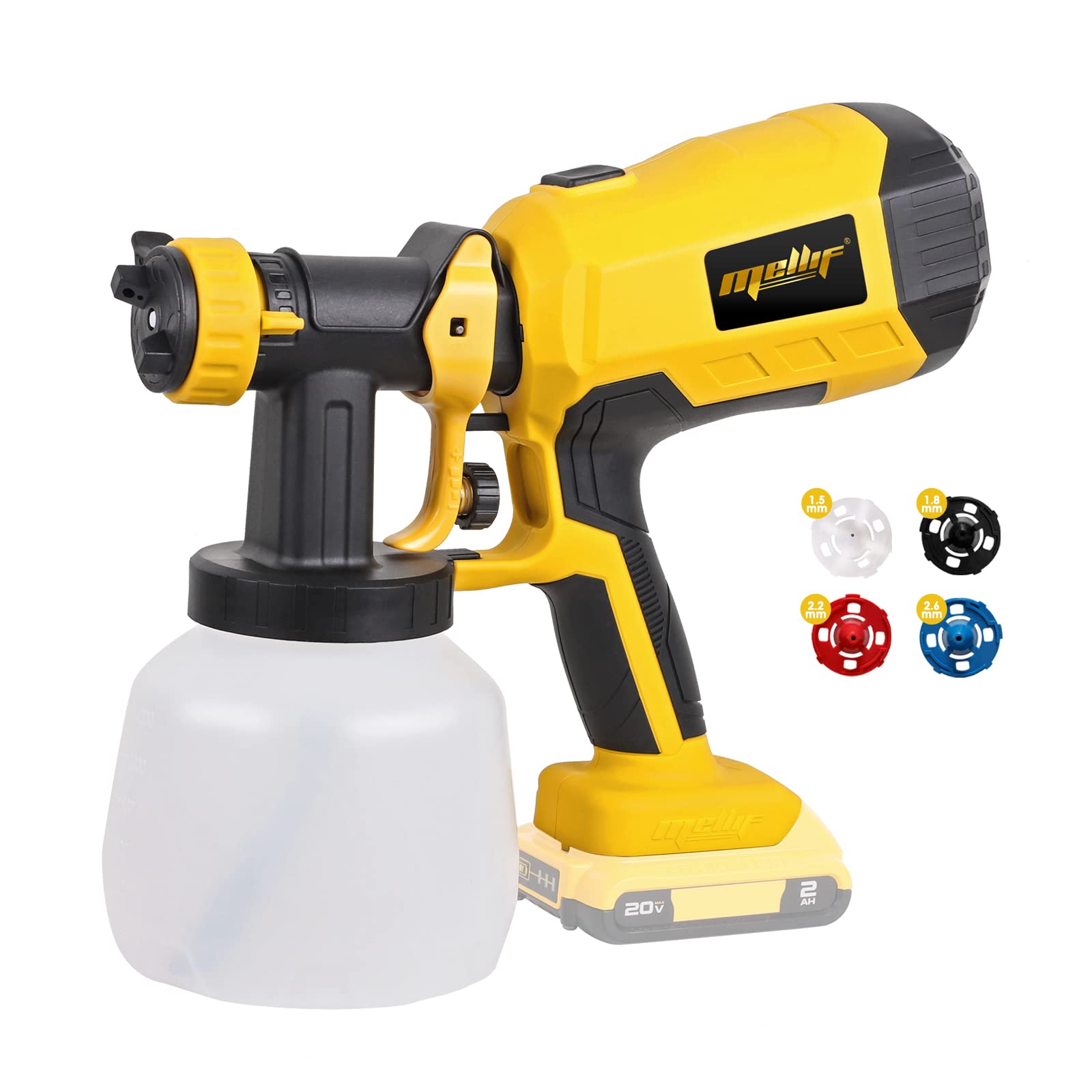
 Paint Sprayer Reviews & Buying Guides1 day ago
Paint Sprayer Reviews & Buying Guides1 day agoDEWALT 20V Cordless Paint Sprayer Review (2023)
-
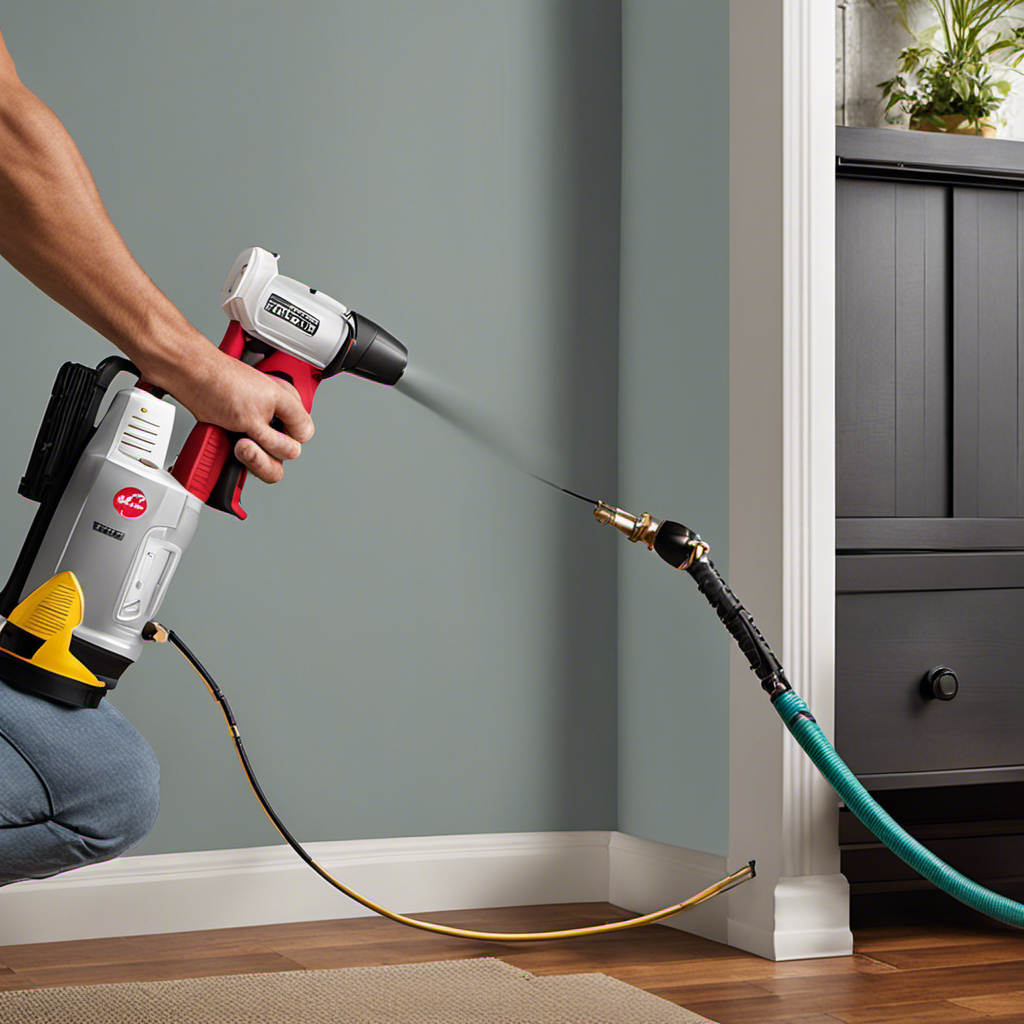
 Paint Sprayer Reviews & Buying Guides3 months ago
Paint Sprayer Reviews & Buying Guides3 months agoCalculating Paint Needs for Airless Sprayer: Coverage, Surfaces, and Tips (2023)
-
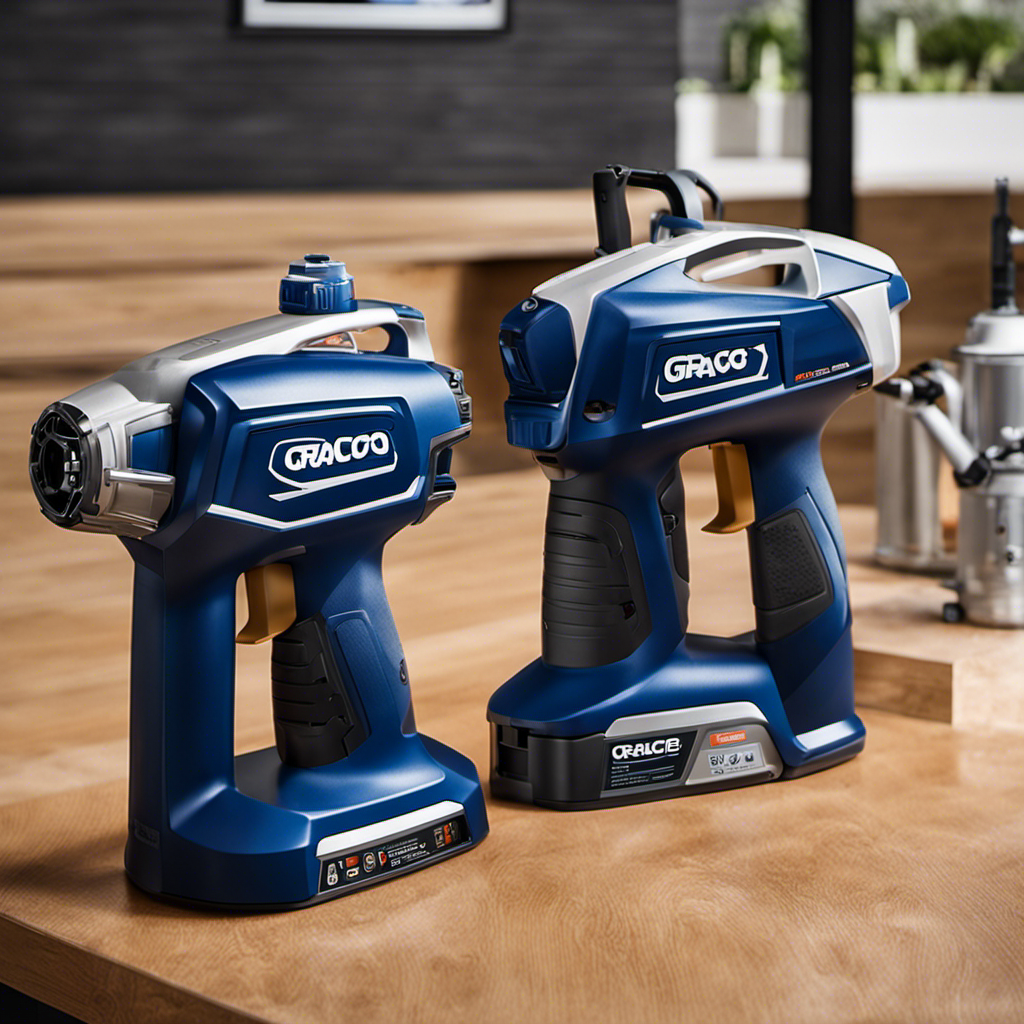
 Paint Sprayer Reviews & Buying Guides3 months ago
Paint Sprayer Reviews & Buying Guides3 months agoGraco Truecoat 360: DSP Vs VSP – a Comparison of Power and Portability (2023)
-

 How-To & Tips3 months ago
How-To & Tips3 months agoMastering the Avanti Airless Paint Sprayer: Tips and Techniques
-
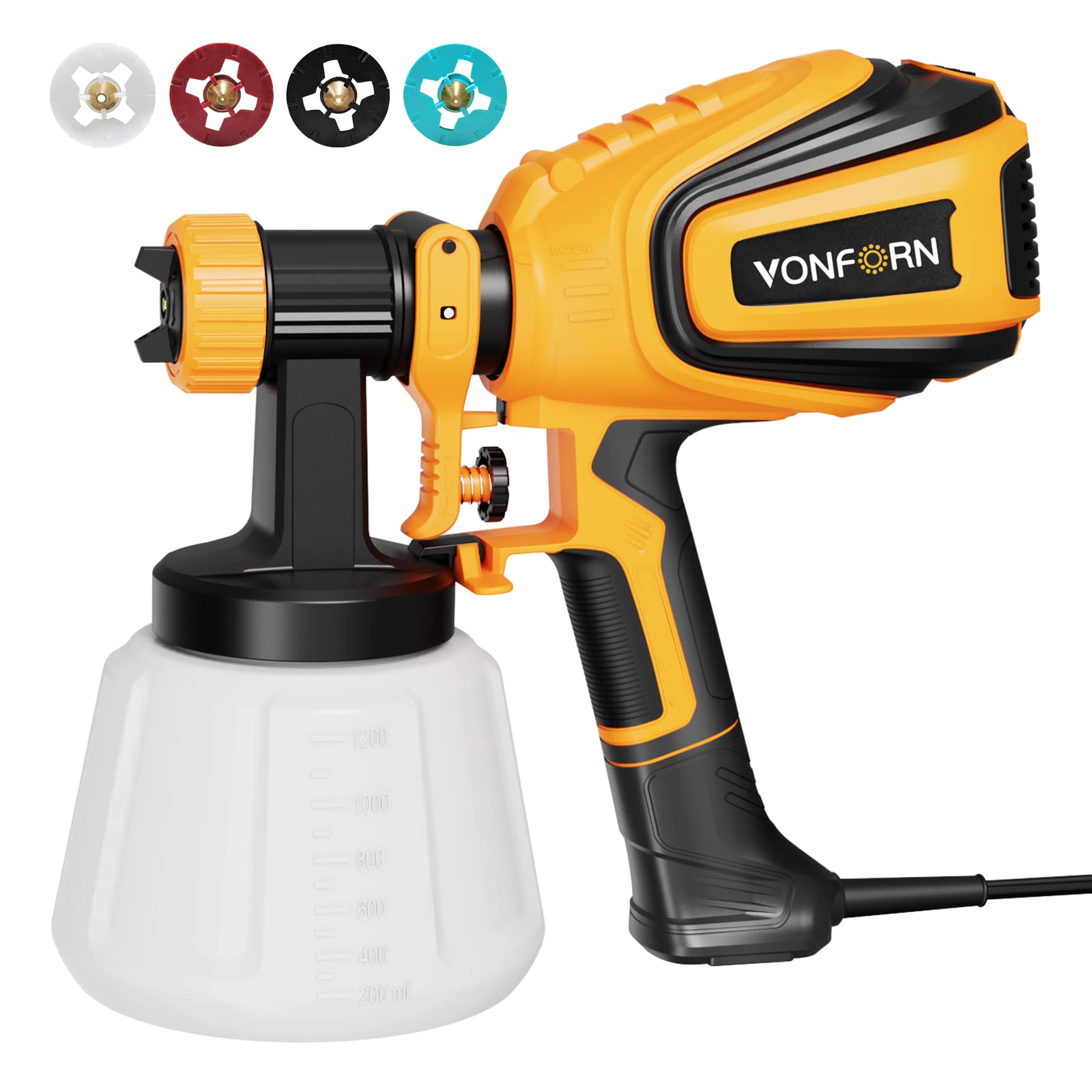
 Paint Sprayer Reviews & Buying Guides2 days ago
Paint Sprayer Reviews & Buying Guides2 days agoVONFORN Paint Sprayer Review: High Performance HVLP Spray Gun (2023)
-

 Paint Sprayer Reviews & Buying Guides1 week ago
Paint Sprayer Reviews & Buying Guides1 week agoSpray Painting Hazards: Safety Measures and Compliance (2023)
-
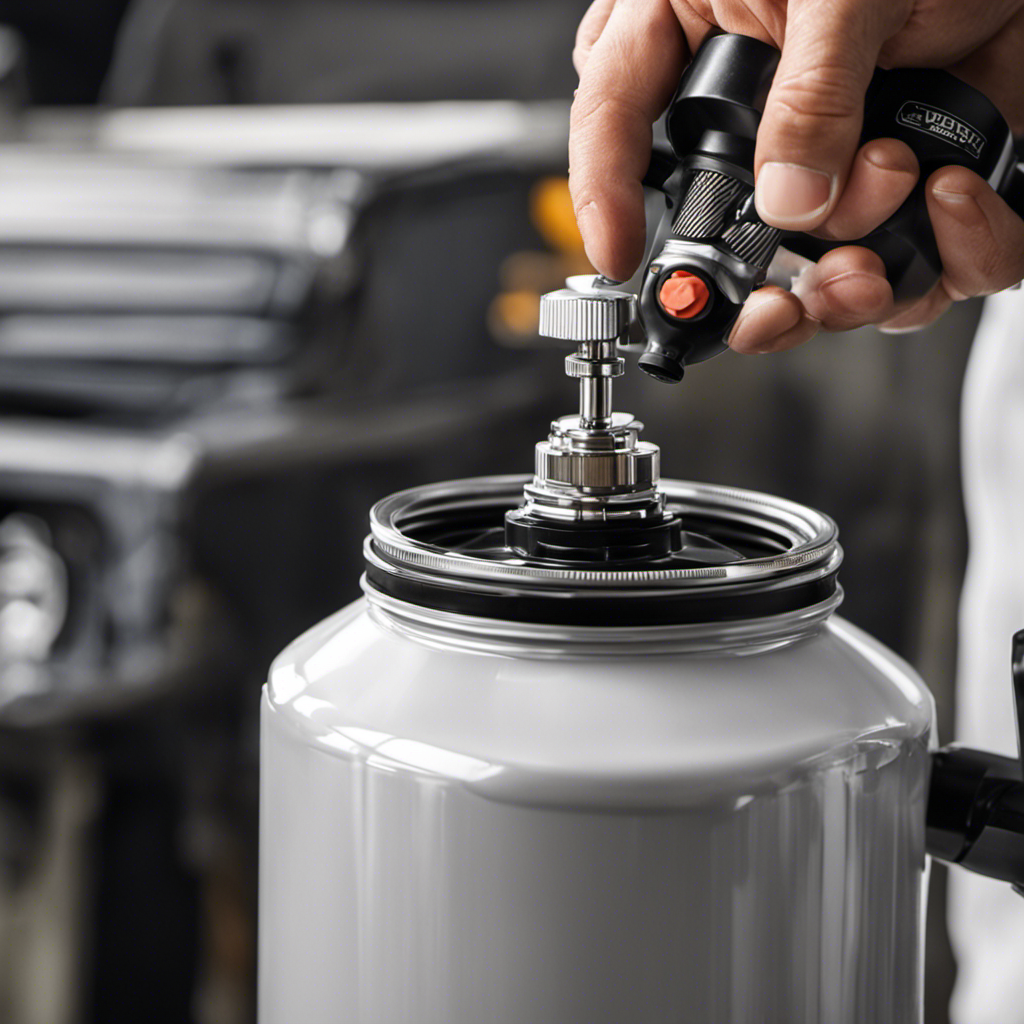
 Paint Sprayers FAQs3 days ago
Paint Sprayers FAQs3 days agoHow to Adjust Pressure on Airless Paint Sprayer
-

 Paint Sprayer Maintenance and Troubleshooting3 months ago
Paint Sprayer Maintenance and Troubleshooting3 months agoWhy Using the Right Oil Matters for Your Airless Paint Sprayer
